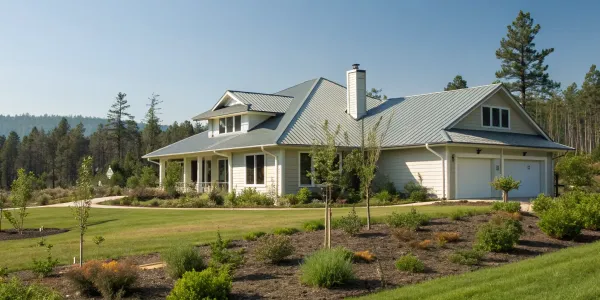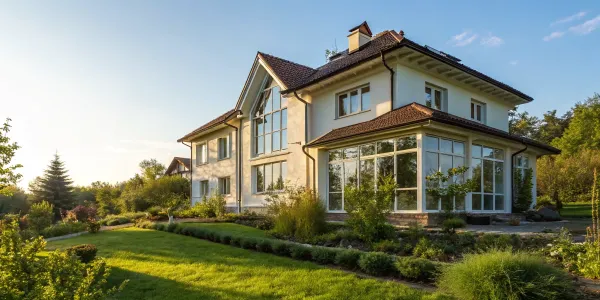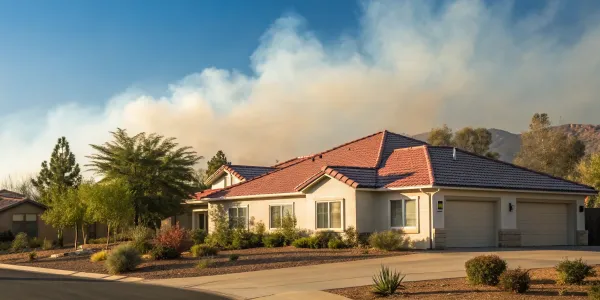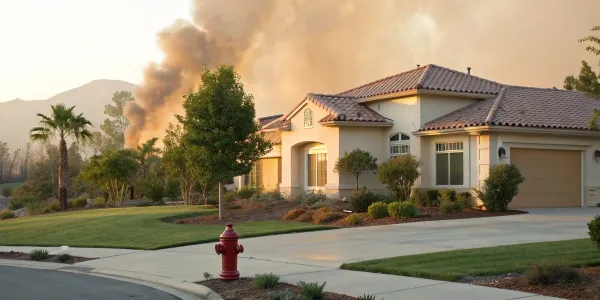Is Smart Siding Fire Resistant? The Honest Answer
Is smart siding fire resistant? Learn how LP SmartSide stands up to fire, what makes it safer than wood, and what to know before choosing siding for your home.
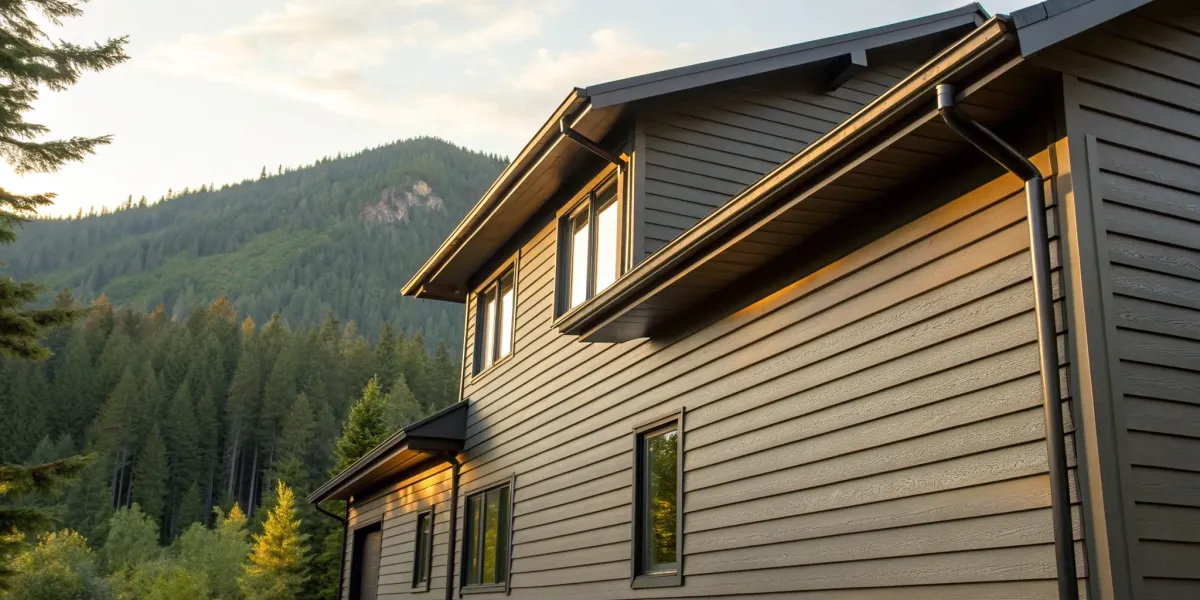
Let’s start with a crucial distinction: “fire-resistant” does not mean “fireproof.” No siding material can make your home invincible, and understanding this is the first step toward building a genuinely safer house. The goal is to choose materials that slow down combustion, resist ignition from flying embers, and give your family precious time to get to safety. With that in mind, many people wonder, is smart siding fire resistant? This question is at the core of building a resilient home. We’ll explore the science behind its protective qualities, how it stacks up against other materials, and why its performance is ultimately tied to the entire wall system it’s a part of.
WiserBuild CTA Button
Key Takeaways
- A fire-rated wall is more than just siding: Your siding’s true fire resistance comes from being installed as part of a complete system. To achieve a one-hour fire rating, it must be paired with specific materials like Type X gypsum sheathing, creating an assembly that meets code and improves safety.
- Extend fire safety beyond your walls: A resilient home uses multiple layers of defense that work together. Combine fire-resistant siding with other smart choices like non-combustible roofing, enclosed eaves, and strategic landscaping to create defensible space around your property.
- Fire ratings directly impact compliance and insurability: Understanding the difference between a material's surface rating and a full assembly's one-hour rating is essential. This knowledge helps you meet local building codes and prove to insurers that you’ve taken clear steps to reduce your home’s risk.
What Makes LP SmartSide Fire-Resistant?
When you’re building a home, especially in an area prone to wildfires, the materials you choose matter immensely. LP SmartSide is a popular engineered wood siding, but a common question is whether it’s truly fire-resistant. The short answer is yes, it offers significant fire resistance, but it’s important to understand that “fire-resistant” doesn’t mean “fireproof.” The protection comes from a specific manufacturing process and a blend of carefully chosen materials designed to slow down the spread of flames, giving you and your family precious time in an emergency. Let’s break down exactly what gives this siding its protective edge.
How SmartGuard Technology Works
At the heart of LP SmartSide’s durability is its proprietary SmartGuard® process. This isn’t just a surface-level coating; it’s a multi-step treatment that infuses the wood strands with protective ingredients before they’re pressed into the final siding product. Think of it as building safety into the siding from the inside out. This process includes treating the wood with fire-retardant additives like zinc borate, which fundamentally changes how the material reacts to heat and flames. The result is a siding that’s far more resilient against fire than untreated wood, making it a smart component in a fire-resistant building plan.
The Fire-Retardant Materials Inside
So, what exactly goes into the SmartGuard process? It’s a specific recipe of four key components that work together. The engineered wood substrate is treated with a powerful blend of waxes, advanced resins, and zinc borate, then finished with a resin-saturated overlay. The waxes provide moisture resistance, while the resins add incredible strength and impact resistance. For fire safety, the star player is zinc borate. This combination of materials makes LP SmartSide a WUI-compliant solution when installed as part of an approved assembly, helping your home meet the strict building codes in wildfire-prone areas.
How Engineered Wood Adds Protection
The engineered wood itself contributes to the siding’s performance. Unlike traditional wood siding, which can have knots and inconsistencies, LP SmartSide is manufactured for uniformity and strength. This consistency means it performs predictably when exposed to fire. When tested, LP SmartSide products achieve a Class C fire rating, which is standard for many common building materials. More importantly, they can be included in a 1-hour fire-rated assembly. This means that when combined with other specific materials, like Type X gypsum sheathing, the complete wall system can resist fire penetration for at least one hour—a critical safety benchmark.
The Role of Zinc Borate
Let’s focus on zinc borate, as it’s the key ingredient for fire resistance. This compound is infused deep into the wood strands during the manufacturing process. When exposed to high heat, zinc borate works by promoting the formation of char on the wood’s surface. This char layer acts as an insulator, slowing down the combustion process and reducing the rate at which flames can spread. It also helps to reduce smoke production. By interfering with the fire’s fuel source—the wood itself—zinc borate enhances the siding’s ability to withstand fire, providing an essential layer of defense for your home.
How Fire Ratings and Tests Work
When you see a "fire-resistant" label on a building material, it’s not just a marketing claim. That label is backed by standardized tests that measure exactly how a material behaves in a fire. Understanding these ratings is the key to choosing products that genuinely protect your home and meet local safety requirements. It’s about looking past the surface-level promises and getting to the data that shows how your siding will perform when it matters most.
These tests don’t just evaluate one material in isolation; they often look at how it works as part of a complete system, like an entire wall. This is crucial because fire resistance depends on how all the components—siding, sheathing, insulation, and drywall—work together. Knowing the difference between a material’s surface rating and a full assembly rating will help you make informed decisions that improve your home's safety and insurability.
What Is a Class C Fire Rating?
A Class C fire rating is a standard classification for building materials based on how quickly flames spread across their surface. Materials are rated from Class A (most fire-resistant) to Class C. LP SmartSide products, for example, carry a Class C rating. This means they have a flame spread index between 76 and 200. While Class A materials like brick or fiber cement offer the highest level of protection against flame spread, a Class C rating still indicates that the material meets specific safety standards required for many residential applications. It’s an important baseline for fire performance.
How Siding Is Tested for Fire Safety
Siding materials get their fire ratings from a highly controlled test called the ASTM E84, also known as the Steiner Tunnel Test. During this test, a sample of the material is placed in a horizontal tunnel, and a flame is applied to one end. Testers measure how far and how fast the flame spreads across the surface and how much smoke is produced. This process provides the data needed to assign a rating like Class A, B, or C. It’s a standardized way to compare the surface burning behavior of different materials, giving you a reliable benchmark for evaluating your siding options.
What Is a One-Hour Fire-Rated Assembly?
A one-hour fire rating doesn't apply to the siding alone but to the entire wall system, or "assembly." This is a critical distinction. An assembly includes the siding, sheathing, wall studs, insulation, and interior drywall all working together. To earn a one-hour rating, the complete wall must be able to withstand direct fire exposure for at least 60 minutes without failing or allowing the fire to penetrate to the other side. This rating is about containment—giving you and your family precious time to evacuate and for first responders to arrive. The real strength of a product like LP SmartSide is revealed when it’s part of a properly constructed, fire-rated assembly.
Meeting Local Building Codes
Fire ratings are directly tied to your local building codes, especially in high-risk areas or for homes built close to one another. For instance, many building codes require a one-hour fire-rated wall assembly for any exterior wall located less than five feet from a property line. This is designed to prevent a fire from easily jumping from one house to the next. Because these requirements can vary significantly by state, county, and even city, it’s essential to verify the specific codes for your project. Ensuring your plans meet these standards from the start is the best way to avoid costly delays and ensure your home is both safe and compliant.
How SmartSide Compares to Other Siding
Choosing the right siding for your home involves balancing aesthetics, budget, and durability. But when you live in an area prone to wildfires, fire resistance becomes one of the most critical factors in your decision. LP SmartSide is a popular choice, but it’s important to see how it stacks up against other common materials. Each option has its own profile of strengths and weaknesses, and understanding them helps you make an informed choice for your home’s safety and longevity.
Your siding is your home's first line of defense, not just against the elements but against potential fire threats. Let's break down how SmartSide compares to traditional wood, vinyl, and fiber cement so you can feel confident in your building plan.
SmartSide vs. Traditional Wood
There’s no denying the classic, beautiful look of traditional wood siding. However, its natural charm comes with a major drawback in high-risk areas: it’s combustible. LP SmartSide was created to solve this problem. As an engineered wood product, it mimics the warm aesthetic of real wood but is treated with zinc borate to resist fungal decay, termites, and fire.
While untreated wood can easily ignite and fuel a fire, SmartSide’s protective treatment helps it char instead of bursting into flames, slowing the spread. This gives it a significant safety advantage over its natural counterpart, offering the look you love without the same level of risk.
SmartSide vs. Vinyl
Vinyl siding is a popular, low-cost option known for its minimal maintenance requirements. When it comes to durability, however, the two materials perform very differently. SmartSide is more rigid and offers better protection against impacts from hail or debris. In terms of fire safety, there’s a clear distinction. When exposed to high heat, vinyl siding can melt and warp, potentially exposing the underlying structure of your home to flames.
SmartSide, on the other hand, is designed to withstand heat more effectively and won't melt away. While vinyl might be easier on the wallet upfront, SmartSide provides a more resilient and reliable barrier in a fire-prone environment.
SmartSide vs. Fiber Cement
Fiber cement, like James Hardie siding, is often considered the gold standard for fire resistance because it's non-combustible and typically carries a Class A fire rating. This makes it an excellent choice for homes in high-risk zones. However, SmartSide has its own advantages, particularly during installation. It’s significantly lighter than fiber cement, making it easier, faster, and often cheaper to install.
While fiber cement offers superior fire protection on its own, a properly constructed wall assembly using SmartSide can still provide excellent, code-compliant fire resistance. Your choice may come down to balancing your budget, installation logistics, and the specific fire-rating requirements for your property.
Choose the Right Siding for Your Home
Ultimately, the best siding for your home depends on your priorities. If you live in a wildfire-prone area, your decision should weigh heavily on fire resistance. Choosing a material like SmartSide isn't just about curb appeal; it's a critical investment in your home's safety and your family's peace of mind. By understanding how different materials perform under pressure, you can create a building plan that is both beautiful and resilient.
Making smart material choices from the start is the most effective way to build a more insurable home that stands strong against potential threats.
Install Siding for Maximum Fire Protection
Even the best fire-resistant siding won't perform as expected if it's not installed correctly. The material itself is just one part of the equation; how it's integrated into your home's wall assembly is what truly creates a protective barrier. Getting the installation details right is critical for safety, code compliance, and even your home's insurability. Here are the key steps to follow to ensure your siding offers the maximum fire protection it was designed for.
Follow Key Installation Steps
To get the most out of your siding’s fire-resistant properties, you have to follow the manufacturer's specifications to the letter. For LP SmartSide, a critical step is installing it over 5/8-inch Type X gypsum wallboard. This specific type of drywall is formulated for fire resistance and is essential if you want to achieve a one-hour fire rating. This isn’t just a suggestion—it’s a requirement for creating a wall assembly that can stand up to fire and meet stringent building codes. Think of it as the foundation of your home’s exterior defense system.
Integrate Type X Gypsum Sheathing
While Type X gypsum is the baseline for a one-hour fire rating, you can strengthen your home’s defenses even further. For added protection, you can pair your siding with specialized sheathing designed to resist fire. Products like LP FlameBlock Fire-Rated Sheathing are engineered to slow the spread of flames, giving you and your family more time to get to safety. This layered approach—combining fire-resistant siding with fire-rated sheathing—creates a more robust system that significantly improves the resilience of your home, which is something insurers look for in high-risk areas.
Seal Gaps and Joints Correctly
A chain is only as strong as its weakest link, and for siding, that weak link is often unsealed gaps and joints. Properly sealing all cut edges, joints, and openings is crucial. When these areas are left exposed, they can absorb moisture, which leads to swelling, warping, and deterioration of the siding. This damage doesn't just look bad; it compromises the material's structural integrity and can reduce its ability to resist fire. Taking the time to caulk and seal every gap ensures your siding remains a solid, unbroken shield against both weather and fire.
Maintain Your Siding for Lasting Safety
Your siding’s performance depends on its condition, so a little upkeep goes a long way. Regular maintenance is key to ensuring its longevity and protective qualities. Plan to walk around your house at least once a year to visually inspect the siding for any signs of damage, like cracks or chips, and check that the sealant around joints and windows is still intact. For cleaning, all you need is a soft brush or cloth and a simple solution of mild detergent and water. This simple routine helps keep your siding in top shape, so it’s always ready to protect your home.
Build a Complete Fire-Safe Home
Choosing the right siding is a critical step, but it’s just one piece of a much larger puzzle. A truly fire-safe home is built as a complete system, where every component—from the roof down to the landscaping—works together to reduce risk. Think of it like layers of defense. Your siding is an important outer layer, but its effectiveness depends on the layers behind it and the environment surrounding it.
This holistic approach considers how embers travel, where heat builds up, and what materials are most likely to ignite. It means looking beyond a single product’s fire rating and focusing on how the entire structure will perform when threatened by a wildfire. By integrating fire-resistant materials and smart design choices throughout your property, you create a more resilient home that can better withstand extreme conditions. This comprehensive strategy not only improves safety but also gives you a stronger case when discussing your home’s risk profile with insurers.
Key Features of a Fire-Safe Design
A fire-safe design starts before you even break ground and extends into your yard. This is where the concept of "firescaping" comes in. As the experts at Fire Safe Marin explain, firescaping uses fire-resistant designs and materials, along with careful plant selection, to strategically resist the spread of fire to your home. This includes creating defensible space by clearing flammable vegetation near the house and using non-combustible materials like gravel or pavers for walkways. Other key features include non-combustible roofing, enclosed eaves to prevent embers from getting trapped, and multi-pane tempered glass windows that resist breaking from heat.
Common Myths About Fire Resistance
One of the biggest myths in fire-safe construction is the idea that any material can be "fireproof." The reality is that nearly everything will burn if the conditions are right. This applies to both landscaping and building materials. For example, while some plants are marketed as fire-resistant, "all plants can burn regardless of how they are classified" when exposed to enough heat and flame. The same principle holds true for siding. No siding can make your home invincible. The goal isn’t to find a fireproof solution but to use materials and assemblies that resist ignition and slow the spread of fire, giving you and first responders valuable time.
Know the Limitations of Your Siding
Even advanced products like LP SmartSide have their limits. While it’s a fantastic choice for its durability and aesthetic, it’s important to have realistic expectations about its fire performance. According to LP Building Solutions, "LP SmartSide siding is treated with a SmartGuard® process that includes fire-retardant treatments like zinc borate, making it more fire-resistant than untreated wood, though it is not fireproof." This treatment helps the siding resist catching fire from embers and slows down combustion, but it will eventually burn when exposed to direct flame. Understanding this helps you make informed decisions about adding other protective layers.
Add Other Layers of Protection
To get the best fire performance from your siding, you need to install it as part of a fire-rated assembly. This means pairing it with other fire-resistant materials that work together as a system. For instance, to achieve a one-hour fire rating, "LP SmartSide siding is often installed with other fire-resistant materials like 5/8" Type X gypsum or LP FlameBlock Fire-Rated Sheathing." This interior layer of protection is crucial because it helps prevent a fire from breaching the exterior wall and entering the home. Proper installation, including sealing all gaps and joints where embers could penetrate, is just as important as the materials you choose.
How Siding Choices Impact Your Insurance
Your building material choices have a direct impact on your home's insurability, especially in high-risk areas. Insurers are paying closer attention to how homes are constructed, and using recognized fire-resistant materials can make a significant difference. As siding manufacturer Nichiha USA notes, "Fire-resistant siding helps make your home safer and last longer." Demonstrating that you’ve used a complete fire-rated wall assembly and followed best practices for fire-safe design can make it easier to secure coverage. It shows insurers that you’ve taken proactive steps to mitigate risk, making your home a more attractive, and less volatile, property to underwrite.
Related Articles
- Best Fire Resistant Siding: A Buyer's Guide
- 7 Key Elements of Fire-Resistant House Plans
- Lightweight Fireproof Material: The Ultimate Guide
WiserBuild CTA Button
Frequently Asked Questions
Is LP SmartSide considered "fireproof"? No, and it’s a really important distinction to make. No siding material is truly fireproof. LP SmartSide is fire-resistant, which means it’s designed to slow down the spread of flames. Thanks to the zinc borate treatment in its SmartGuard process, the siding chars on the surface when exposed to high heat. This char layer acts as an insulator, buying you precious time in an emergency. Think of it as a key component in a larger safety system, not an invincible shield.
Why is a "one-hour fire rating" so important if it only lasts an hour? That hour is about giving you and your family a critical window of time to get out safely. The one-hour rating doesn't apply to the siding alone but to the entire wall assembly—the siding, sheathing, studs, and drywall working together. This rating means the complete wall can withstand direct flames for at least 60 minutes without letting the fire breach the interior of your home. It’s a life-safety standard designed for containment, giving first responders a better chance to arrive and manage the situation.
If fiber cement has a better fire rating, why would I choose SmartSide? While fiber cement is non-combustible and carries a top-tier Class A rating, your material choice often involves balancing several factors. LP SmartSide offers a significant advantage in its workability. It's much lighter than fiber cement, which makes it faster, easier, and generally less expensive to install. When installed as part of a proper one-hour fire-rated assembly, SmartSide provides excellent, code-compliant protection, giving you a resilient option that can also be more friendly to your project's timeline and budget.
Does just choosing fire-resistant siding make my home safe from wildfires? Unfortunately, no single element can make a home completely safe. Your siding is your home's first line of defense, but it's just one part of a comprehensive strategy. A truly fire-resilient home is built as a system. This includes using non-combustible roofing materials, enclosing your eaves to block embers, installing multi-pane windows, and creating defensible space by clearing flammable vegetation away from the structure. Each element works with the others to reduce your home's overall vulnerability.
Will using a fire-rated wall system actually help with my home insurance? Yes, it absolutely can. Insurers are increasingly focused on a home's risk profile, especially in wildfire-prone regions. When you can demonstrate that you’ve used a complete fire-rated wall assembly and incorporated other fire-safe building practices, you are showing that you have actively taken steps to mitigate risk. This makes your home a more favorable property to insure and can be a key factor in securing coverage and keeping your policy in good standing.

